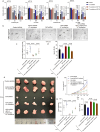Fusobacterium nucleatum induces chemoresistance in colorectal cancer by inhibiting pyroptosis via the Hippo pathway
- PMID: 38533566
- PMCID: PMC10978024
- DOI: 10.1080/19490976.2024.2333790
Fusobacterium nucleatum induces chemoresistance in colorectal cancer by inhibiting pyroptosis via the Hippo pathway
Abstract
Chemotherapy resistance is one of the main reasons for the poor prognosis of colorectal cancer (CRC). Moreover, dysbiosis of gut bacteria was found to be a specific environmental risk factor. In this study, enrichment of F. nucleatum was elucidated to be significantly associated with CRC recurrence after chemotherapy. Functional experiments showed that F. nucleatum could inhibit pyroptosis induced by chemotherapy drugs, thereby inducing chemoresistance. Furthermore, mechanistic investigation demonstrated that F. nucleatum could regulate the Hippo pathway and promote the expression of BCL2, thereby inhibiting the Caspase-3/GSDME pyroptosis-related pathway induced by chemotherapy drugs and mediating CRC cell chemoresistance. Taken together, these results validated the significant roles of F. nucleatum in CRC chemoresistance, which provided an innovative theoretical basis for the clinical diagnosis and therapy of CRC.
Keywords: Fusobacterium nucleatum; GSDME; YAP; chemoresistance; colorectal cancer; pyroptosis.
Conflict of interest statement
No potential conflict of interest was reported by the author(s).
Figures







References
-
- Andre T, Boni C, Navarro M, Tabernero J, Hickish T, Topham C, Bonetti A, Clingan P, Bridgewater J, Rivera F. et al. Improved overall survival with oxaliplatin, fluorouracil, and leucovorin as adjuvant treatment in stage II or III colon cancer in the MOSAIC trial. J Clin Oncol. 2009;27(19):3109–3116. doi:10.1200/JCO.2008.20.6771. - DOI - PubMed
Publication types
MeSH terms
LinkOut - more resources
Full Text Sources
Medical
Research Materials
